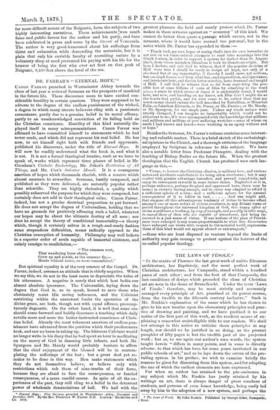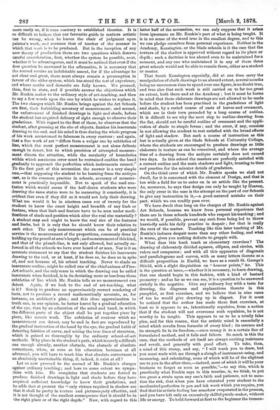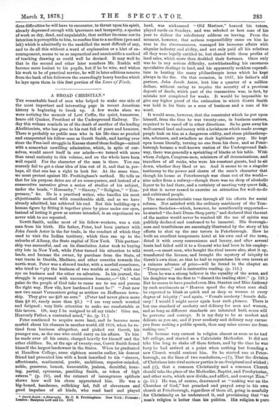THE LAWS OF FESOLE.*
" IN the centre of Florence the last great work of native Etruscan architecture, her Baptistery, and the most perfect work of Christian architecture, her Campanile, stand within a hundred paces of each other ; and from the foot of that Campanile, the last conditions of design which preceded the close of Christian art are seen in the dome of Brunelleschi. Under the term 'Laws of F6.sole,' therefore, may be most strictly and accurately arranged every principle of Art, practised at its purest source, from the twelfth to the fifteenth century inclusive." Such is Mr. Ruskin's explanation of the name which he has chosen to give to his new treatise upon the elementary principles and prac- tice of drawing and painting, and we have prefixed it to our notice of the first part of this work, as the readiest means of ex- plaining a somewhat unintelligible title to our readers. We shall not attempt in this notice to criticise these principles at any length, nor should we be justified in so doing, as the present pamphlet of fifty pages is but the twelfth part of the projected work ; but as, to use again our author's own words, the system taught herein " differs in many points, and in some is directly adverse, to that which has been for some years instituted in our public schools of art," and as he lays down the errors of the pre- vailing system in his preface, we wish to examine briefly the reasons he gives for dissenting from this system, and for adopting the one of which the earliest elements are here expressed.
For when an author has attained to the pre-eminence in• any subject which Mr. Ruskin has justly attained by his writings on art, there is always danger of great numbers of students, and persons of even lesser knowledge, being easily led away by him to the adoption of a new system, and perhaps the
* The Laws of Thole. By John Buskin. Published by George Allan, %wayside, Kent. more easily so, if it rune contrary to established theories. It is so difficult to believe that our favourite guide in matters artistic can be wrong, when he leaves the chair of judgment upon painter's work, and assumes that of teacher of the manner in which that work is to be produced. But in the inception of any new theory of production there are two questions which deserve careful consideration, first, whether the system be possible, next, whether it be advantageous, and it must be noticed that even if the first question be answered in the affirmative, it is necessary that the second receive an indubitable assent, for if the advantage be not clear and great, there must always remain a presumption in favour of the older system, which has stood the test of experience, and whose merits and demerits are fully known. We proceed, then, first to state, and if possible answer the objections which Mr. Ruskin makes to the ordinary style of art-teaching, and then to say a few words upon the one by which he wishes to replace it. The two charges which Mr. Ruskin brings against the Art Schools are first, their forbidding accuracy of measurement; and second, the enforcement of finished drawings in light and shade, before the student has acquired delicacy of sight enough to observe their gradations. With regard to the first of these, he observes that the student, after guessing at the size of objects, finishes his inaccurate drawing to the end, and his mind is thus during the whole progress of his work accustomed to falseness in every contour ; and again, that a fine work of art " differs from a vulgar one by subtleties of line, which the most perfect measurement is not alone delicate enough to detect, but to which precision of attempted measure- ment directs the attention, while the secularity of boundaries within which maximum error must be restrained enables the hand gradually to approach the perfection which instruments cannot.'' To the first part of this accusation the answer is a very simple one,—that supposing the student to be learning from the antique cast, as is the common practice in schools, accuracy of measure- ment is practically impossible. Not to speak of the mad con- fusion which would ensue if the half-dozen students who were drawing the same statue were to be measuring it constantly, it is evident that even if they did so it would not help their drawing. What use would it be in nineteen cases out of twenty for the student to know the exact height and breadth of any limb or feature, when that limb and feature have to be seen under modi- fications of shade and position which alter the real size materially? A. student may and ought to know the real size of the features and limbs, but it is only that he should know their relation to each other. The only measurement which can be of practical service is the measurement of the proportions, commonly done by holding np the pencil at arm's length ; and measuremen t of this kind, and that of the plumb-line, is not only allowed, but actually en- forced in all the schools we have ever heard of or seen. Nor is it an accurate statement to say that the student finishes his inaccurate drawing to the end, or at least, if be does so, he does so in spite of, and not because of, his school teaching. Never to shade an inaccurate outline, might be called one of the chief axioms of Fine- Art schools, and the only sense in which the drawing can be called inaccurate when finished, is in its deviating more or less from those subtleties of line which Mr. Ruskin tells us no measurement can detect. Again, if we look to the end of art-teaching, what is it? Surely to produce an approximately correct rendering of facts, not to produce a record mathematically accurate, as, for instance, an architect's plan ; and this close approximation to truth can, in our opinion, be better learnt by a gradual education of the eye, than by an education of the mind and hand, in which the different parts of the object shall be put together piece by piece, like mosaic work. The subtleties of contour which no measurement can detect, may be and in fact are reproduced by the gradual instruction of the band by the eye, the gradual habit of detecting falsities of curve, and seizing the true lines of structure, which is gained so thoroughly by the ordinary school-of-art methods. Why place in the student's path, which is surely a difficult one enough already, another obstacle, the obstacle of absolute correctness, when, as soon as his education becomes at all advanced, you will have to teach him that absolute correctness is an absolutely unattainable thing, if, indeed, it exist at all ?
Let us now proceed to the second of Mr. Ruskin's charges against ordinary teaching; and here to some extent we sympa- thise with him. He complains that students are forced to produce finished drawings in light and shade before they have acquired sufficient knowledge to know their gradations, and he adds that at present the " only virtues required in shadow are that it shall be pretty in texture and picturesquely effective, and it is not thought of the smallest consequence that it should be in the right place or of the right depth." Now, with regard to this
latter half of the accusation, we can only suppose that it arises from ignorance on Mr. Ruskin's part of what is being taught. It
is in no sense of the word true in the smallest degree, and to this we can pledge ourselves from personal experience. Neither in the Academy, Kensington, or the Slade schools is it the case that the texture of the shadow is approved without regard to its place or depth ; such a doctrine is too absurd even to be maintained fora moment, and any one who maintained it in any of these three great schools would not be able to remain there, either as a student or master.
That South Kensington especially, did at one time carry the manipulation of chalk drawings to an absurd extent, several months being no uncommon time to spend over one figure, is no doubt true, and true also that such work is still carried on to far too great an extent, both there and at the Academy ; but it must be borne in mind that these elaborate drawings are not allowed to be made before the student has been practised in the gradations of light and shade, by a varied course of casts of leaves and ornament, which are in their turn preceded by a long course of outline.
It is difficult to see why the next step to outline-drawing from the flat, should not be careful outline of ornament and the appli- cation of shade to simple forms ; and the error, if any, consists in not allowing the student to rest satisfied with the broad effects of light and shadow. But such a course of instruction as this last is actually given at the Slade Schools at University College, where the students are encouraged to produce drawings as little elaborate in texture as can be conceived, and where the average time of a drawing from the antique certainly does not exceed two days. In this school the masters are perfectly satisfied with a correct outline and the main shadows and light, trusting to time and practice for the minuter details of gradation. On the third error of which Mr. Ruskin speaks we shall not dwell, for it is concerned with the element of Design, and that is too wide a field for us to enter on in an article like the present. As, moreover, he says that design can only be taught by Heaven, the only error in the case is the attempt on the part of our Schools to give any instruction in it,—a good-natured mistake on their part, which we can readily pass over. We have dwelt thus long on the charges of Mr. Ruskin against Art Schools, because we know from personal experience that there are in those schools hundreds who respect his teaching ; and we would, if possible, prevent any such from being led to throw hurriedly aside his daily practice in despair ; for that is really the root of the matter. Teaching like this later teaching of Mr. Ruskin's induces despair more than any other feeling, and what is worse, gives you nothing definite to grapple with. What does this book teach as elementary exercises ? The drawing of elaborately divided squares, ellipses, and circles, with rulers and compasses ; and with all this apparatus of diagonals and parallelograms and curves, with as many letters thereto as a difficult proposition in Euclid, we have as a result St. George's Shield, with a slight disquisition on " honour points," &c. 'This
is the question at issue,—whether it is necessary, to learn drawing, that one should begin in this fashion, with a End of bastard
geometry ; and as far as we can see, it is a question to be answered strictly in the negative. Give any ordinary boy with a taste for drawing, the diagrams and explanations thereto in this pamphlet, as first exercises, and we believe that in nine cases of ten he would give drawing up in disgust. For it must be noticed that the author has made these first exercises, at least so it appears to us, intentionally repulsive, from a notion that if the student will not overcome such repulsion, he is not worthy to be taught. This appears to us to be a totally false plan, and for this reason, that the artistic mind is essentially a mind which revolts from formulae of every kind ; its essence and its strength lie in its freedom,—once cramp it to a certain line of formulated method, and it fails and falters. So much is this the case, that the methods of art itself are always exciting resistance and revolt, and generally with good effect. To take, then, a mind of this stamp, and say, " I will teach you to draw, but you must wade with me through a slough of instrument-using, and measuring, and calculating, none of which will be of the slightest use to you in the after-time,—indeed, most of which it will be your business to forget as soon as possible,"—to say this, which is practically what Ruskin says in this treatise, is, we think, to put too great a strain upon any one's faith and patience, not to men- tion the risk, that when you have educated your student to the mechanical perfection' in pen and ink work which you require, you find that his artistic feeling has somehow evaporated in the process, and you have left only an excessively skilful puzzle-maker, without life or energy. To hold forward at first to the beginner the tremen-
dons difficulties he will have to encounter, to thrust upon his spirit, already depressed enough with ignorance and incapacity, a species of work so dry, dead, and unpalatable, that neither its cause nor its intention is perceptible to him, to confine him to a medium (pen and ink) which is admittedly to the unskilled the most difficult of any, and to do all this without a word of explanation or a hint of en- couragement, seems to us as unpractical and unscientific a method of teaching drawing as could well be devised. It may well be that in the second and other later numbers Mr. Ruskin will become more lenient to his pupils, but if he be wise, and wishes his work to be of practical service, he will in later editions remove from the back of his followers the exceedingly heavy burden which he lays upon them in this first portion of the Laws of Fe'sole.




































 Previous page
Previous page